The UK Private Rental Housing Market: Supply, Demand, and Factors
VerifiedAdded on 2022/08/10
|20
|4328
|415
Report
AI Summary
This report provides a comprehensive analysis of the private rental housing market in the United Kingdom. It begins with an introduction to residential rental property and its significance, highlighting the persistent housing scarcity in the UK and the increasing household numbers. The report then delves into the application of supply and demand principles to the housing market, exploring the factors that influence both supply and demand, such as interest rates, population changes, income levels, and government policies. The analysis covers the distinction between freehold and leasehold ownership, the role of mortgages, and the impact of housing prices on household wealth and consumer behavior. The report also examines how shifts in the supply curve are affected by factors like land availability, building costs, government legislation, subsidies, and technological advancements. The conclusion emphasizes the equilibrium price determination in the private rental housing market and the relatively inelastic nature of supply in the short run. The provided assignment brief includes lecture notes on key economic concepts such as equilibrium, supply and demand shifts, elasticity, monopoly, monopolistic competition, oligopoly, and macroeconomic indicators like unemployment, inflation, and national income.
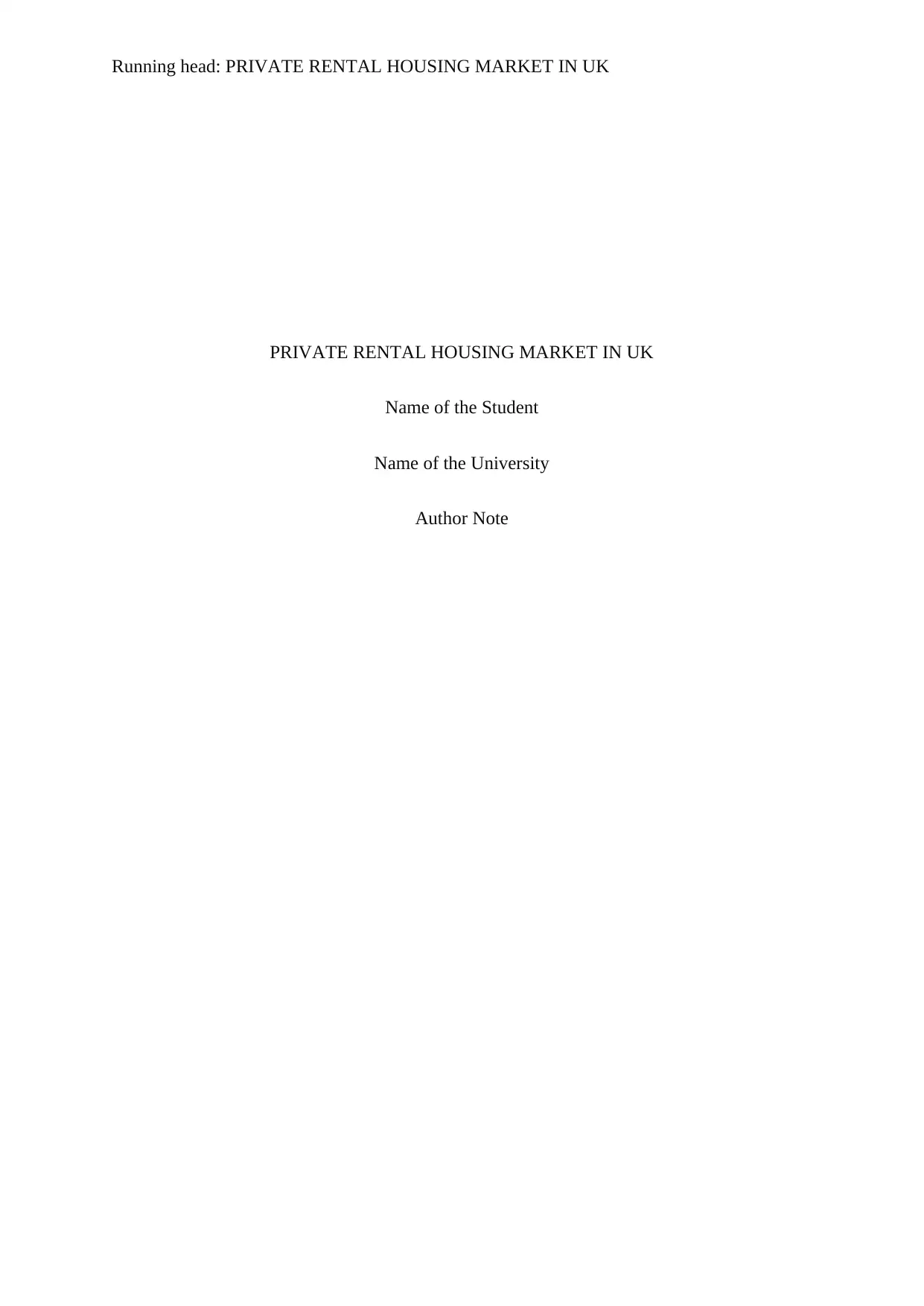
Running head: PRIVATE RENTAL HOUSING MARKET IN UK
PRIVATE RENTAL HOUSING MARKET IN UK
Name of the Student
Name of the University
Author Note
PRIVATE RENTAL HOUSING MARKET IN UK
Name of the Student
Name of the University
Author Note
Paraphrase This Document
Need a fresh take? Get an instant paraphrase of this document with our AI Paraphraser
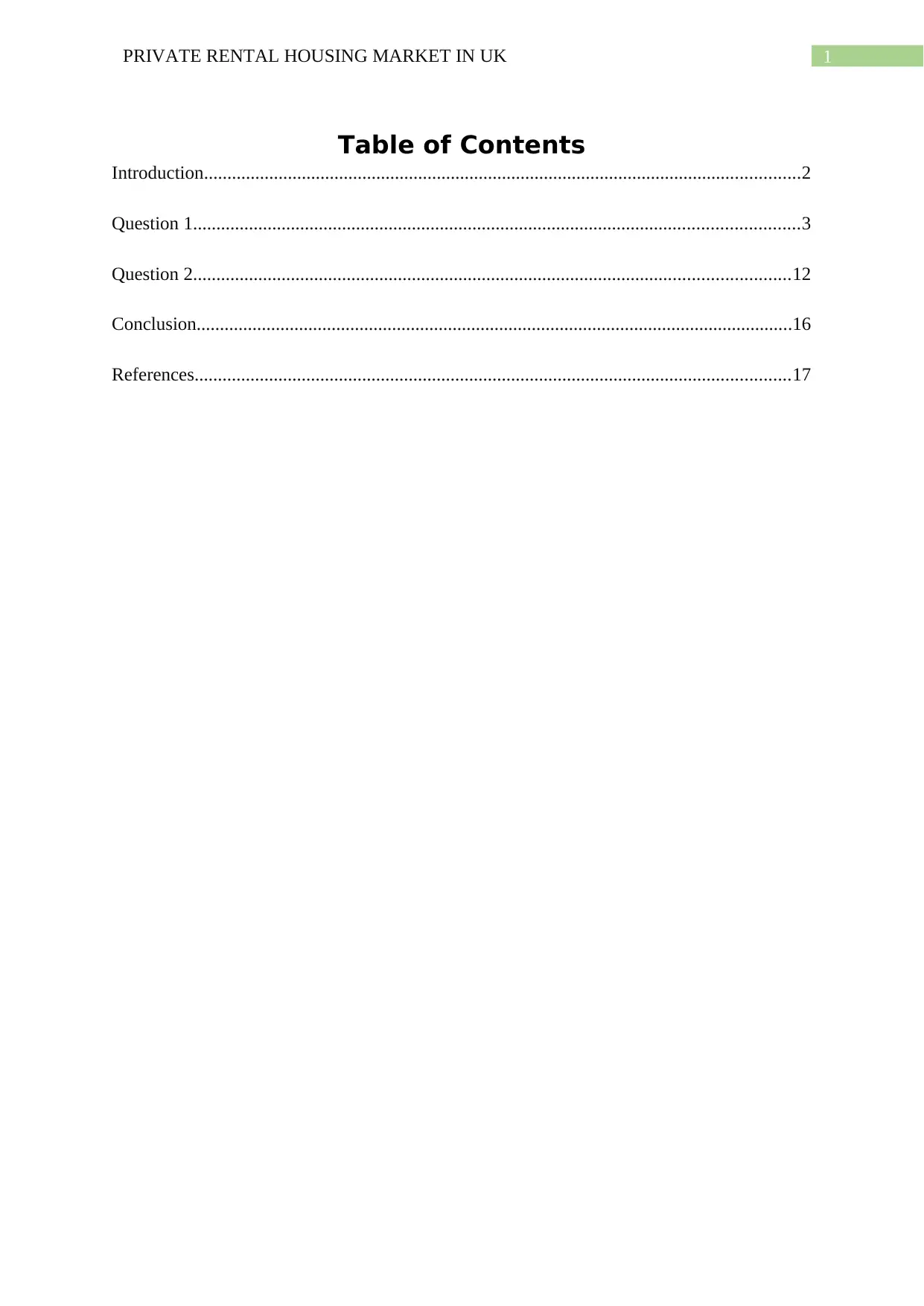
1PRIVATE RENTAL HOUSING MARKET IN UK
Table of Contents
Introduction................................................................................................................................2
Question 1..................................................................................................................................3
Question 2................................................................................................................................12
Conclusion................................................................................................................................16
References................................................................................................................................17
Table of Contents
Introduction................................................................................................................................2
Question 1..................................................................................................................................3
Question 2................................................................................................................................12
Conclusion................................................................................................................................16
References................................................................................................................................17
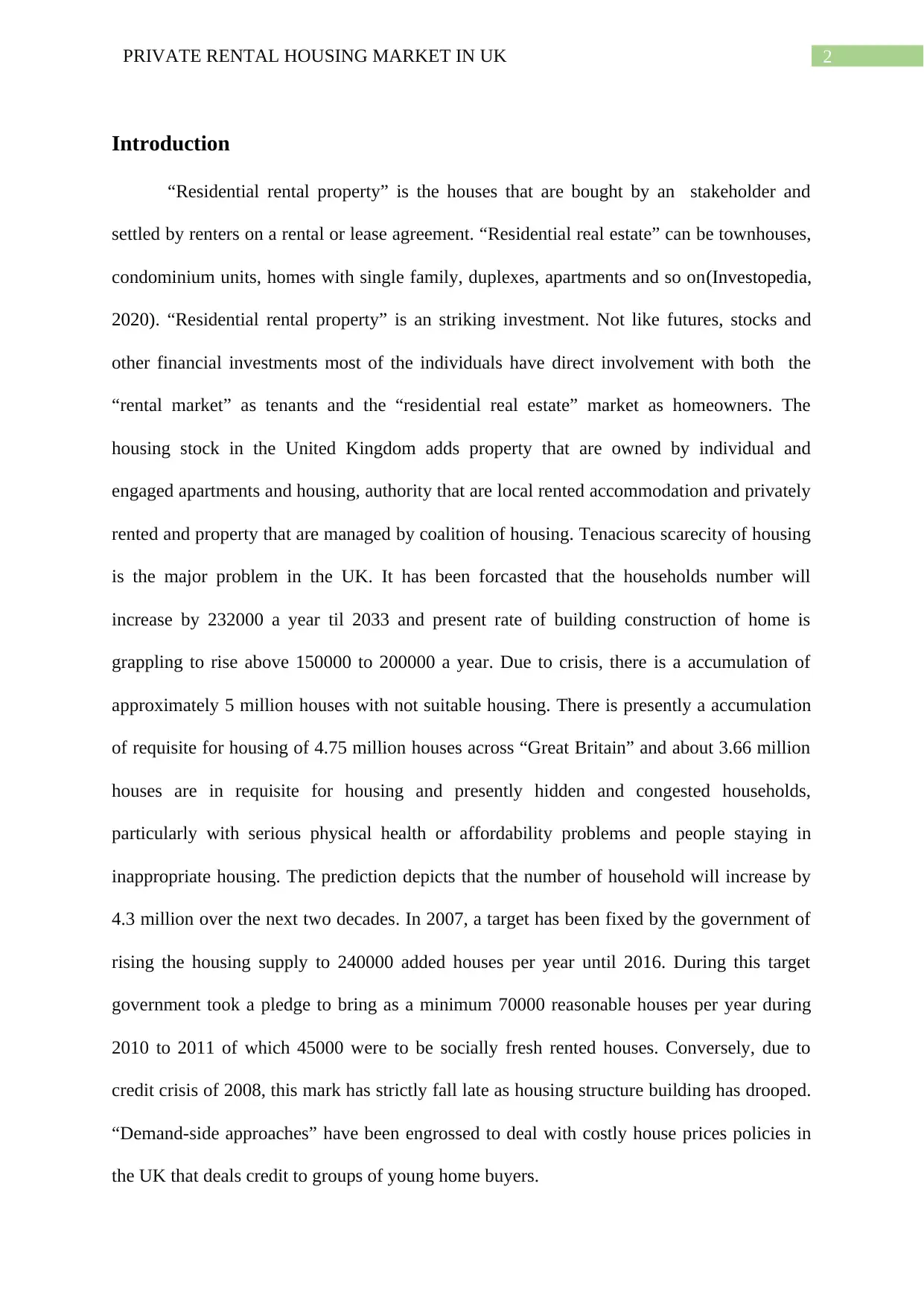
2PRIVATE RENTAL HOUSING MARKET IN UK
Introduction
“Residential rental property” is the houses that are bought by an stakeholder and
settled by renters on a rental or lease agreement. “Residential real estate” can be townhouses,
condominium units, homes with single family, duplexes, apartments and so on(Investopedia,
2020). “Residential rental property” is an striking investment. Not like futures, stocks and
other financial investments most of the individuals have direct involvement with both the
“rental market” as tenants and the “residential real estate” market as homeowners. The
housing stock in the United Kingdom adds property that are owned by individual and
engaged apartments and housing, authority that are local rented accommodation and privately
rented and property that are managed by coalition of housing. Tenacious scarecity of housing
is the major problem in the UK. It has been forcasted that the households number will
increase by 232000 a year til 2033 and present rate of building construction of home is
grappling to rise above 150000 to 200000 a year. Due to crisis, there is a accumulation of
approximately 5 million houses with not suitable housing. There is presently a accumulation
of requisite for housing of 4.75 million houses across “Great Britain” and about 3.66 million
houses are in requisite for housing and presently hidden and congested households,
particularly with serious physical health or affordability problems and people staying in
inappropriate housing. The prediction depicts that the number of household will increase by
4.3 million over the next two decades. In 2007, a target has been fixed by the government of
rising the housing supply to 240000 added houses per year until 2016. During this target
government took a pledge to bring as a minimum 70000 reasonable houses per year during
2010 to 2011 of which 45000 were to be socially fresh rented houses. Conversely, due to
credit crisis of 2008, this mark has strictly fall late as housing structure building has drooped.
“Demand-side approaches” have been engrossed to deal with costly house prices policies in
the UK that deals credit to groups of young home buyers.
Introduction
“Residential rental property” is the houses that are bought by an stakeholder and
settled by renters on a rental or lease agreement. “Residential real estate” can be townhouses,
condominium units, homes with single family, duplexes, apartments and so on(Investopedia,
2020). “Residential rental property” is an striking investment. Not like futures, stocks and
other financial investments most of the individuals have direct involvement with both the
“rental market” as tenants and the “residential real estate” market as homeowners. The
housing stock in the United Kingdom adds property that are owned by individual and
engaged apartments and housing, authority that are local rented accommodation and privately
rented and property that are managed by coalition of housing. Tenacious scarecity of housing
is the major problem in the UK. It has been forcasted that the households number will
increase by 232000 a year til 2033 and present rate of building construction of home is
grappling to rise above 150000 to 200000 a year. Due to crisis, there is a accumulation of
approximately 5 million houses with not suitable housing. There is presently a accumulation
of requisite for housing of 4.75 million houses across “Great Britain” and about 3.66 million
houses are in requisite for housing and presently hidden and congested households,
particularly with serious physical health or affordability problems and people staying in
inappropriate housing. The prediction depicts that the number of household will increase by
4.3 million over the next two decades. In 2007, a target has been fixed by the government of
rising the housing supply to 240000 added houses per year until 2016. During this target
government took a pledge to bring as a minimum 70000 reasonable houses per year during
2010 to 2011 of which 45000 were to be socially fresh rented houses. Conversely, due to
credit crisis of 2008, this mark has strictly fall late as housing structure building has drooped.
“Demand-side approaches” have been engrossed to deal with costly house prices policies in
the UK that deals credit to groups of young home buyers.
⊘ This is a preview!⊘
Do you want full access?
Subscribe today to unlock all pages.

Trusted by 1+ million students worldwide
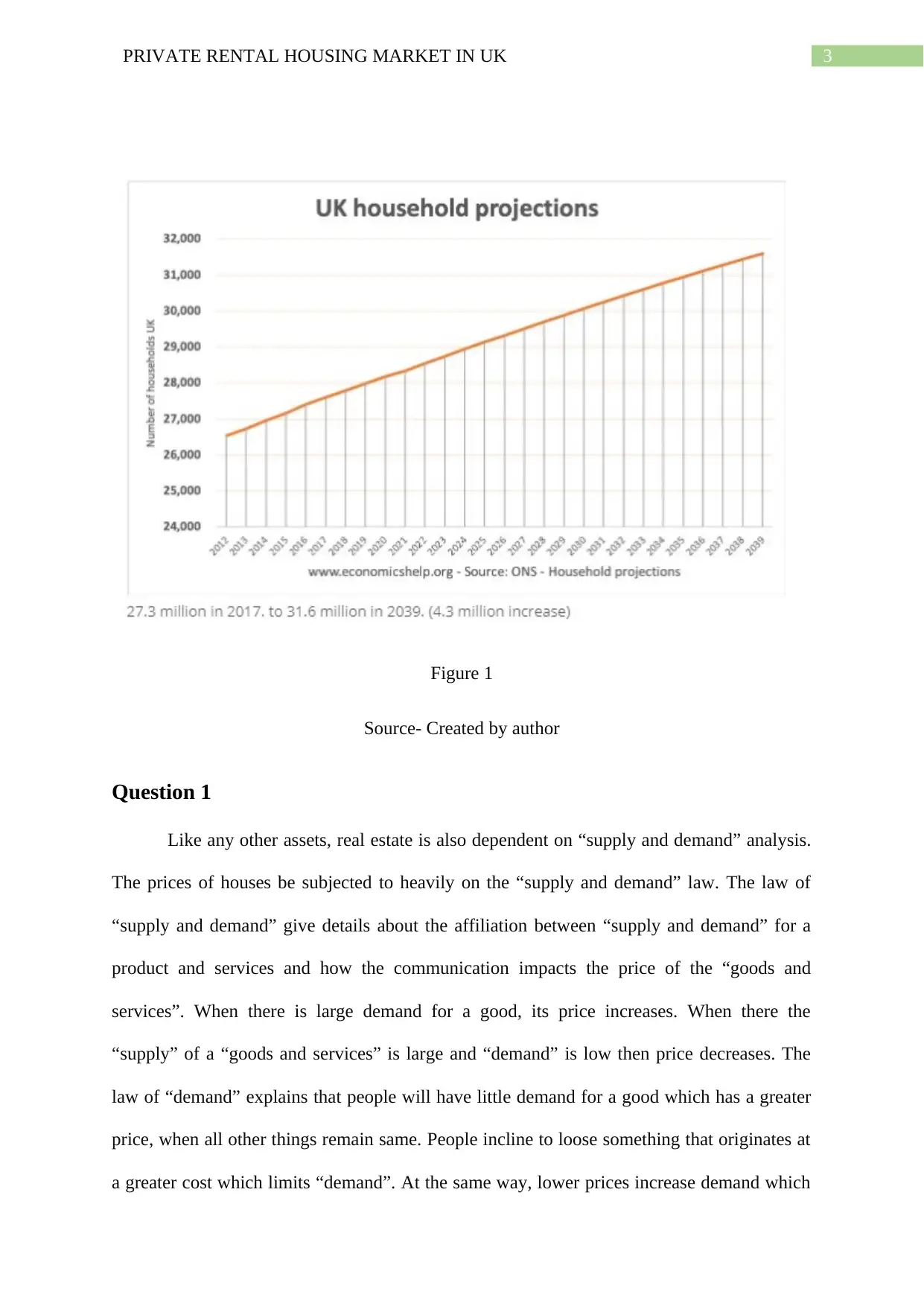
3PRIVATE RENTAL HOUSING MARKET IN UK
Figure 1
Source- Created by author
Question 1
Like any other assets, real estate is also dependent on “supply and demand” analysis.
The prices of houses be subjected to heavily on the “supply and demand” law. The law of
“supply and demand” give details about the affiliation between “supply and demand” for a
product and services and how the communication impacts the price of the “goods and
services”. When there is large demand for a good, its price increases. When there the
“supply” of a “goods and services” is large and “demand” is low then price decreases. The
law of “demand” explains that people will have little demand for a good which has a greater
price, when all other things remain same. People incline to loose something that originates at
a greater cost which limits “demand”. At the same way, lower prices increase demand which
Figure 1
Source- Created by author
Question 1
Like any other assets, real estate is also dependent on “supply and demand” analysis.
The prices of houses be subjected to heavily on the “supply and demand” law. The law of
“supply and demand” give details about the affiliation between “supply and demand” for a
product and services and how the communication impacts the price of the “goods and
services”. When there is large demand for a good, its price increases. When there the
“supply” of a “goods and services” is large and “demand” is low then price decreases. The
law of “demand” explains that people will have little demand for a good which has a greater
price, when all other things remain same. People incline to loose something that originates at
a greater cost which limits “demand”. At the same way, lower prices increase demand which
Paraphrase This Document
Need a fresh take? Get an instant paraphrase of this document with our AI Paraphraser
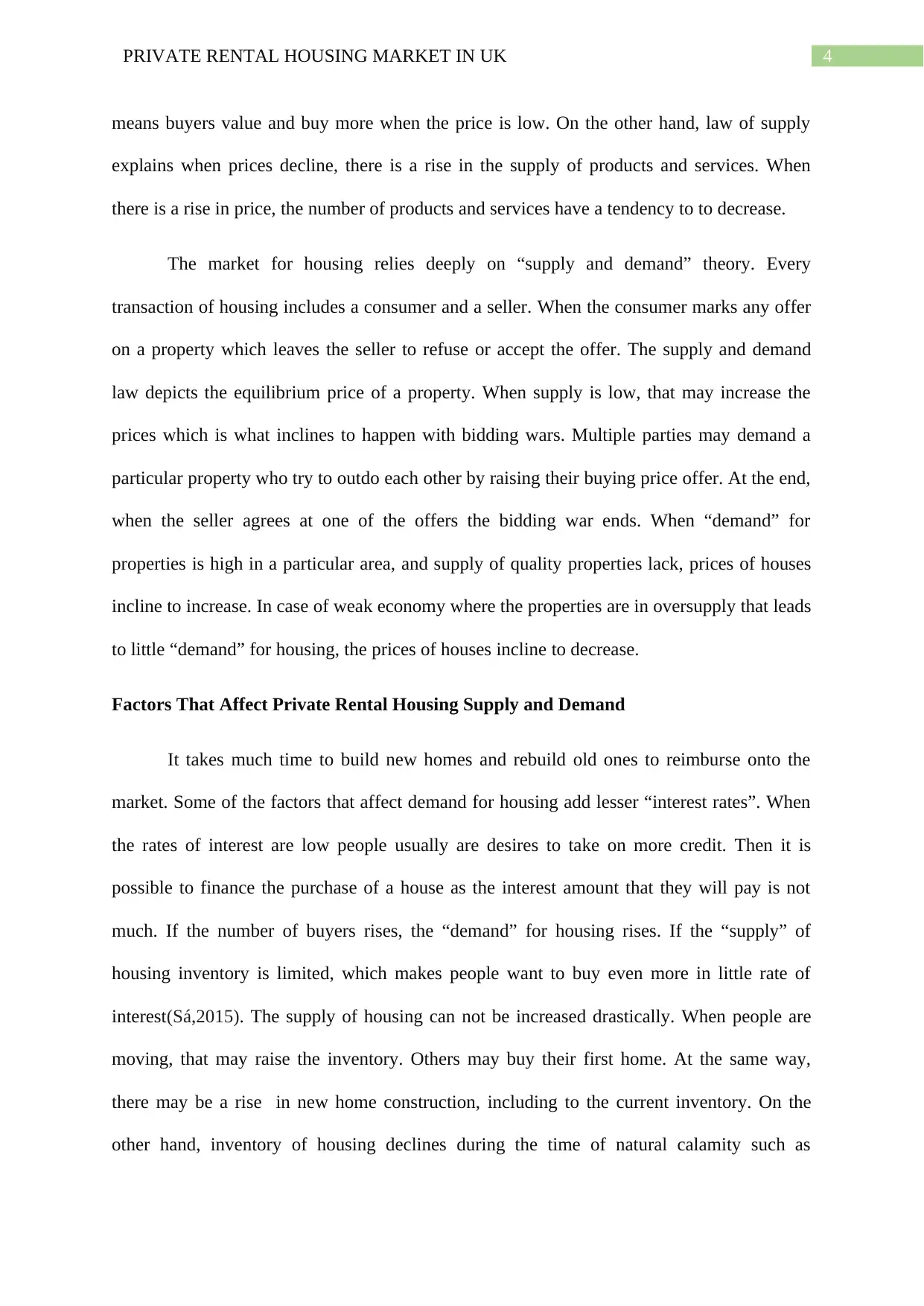
4PRIVATE RENTAL HOUSING MARKET IN UK
means buyers value and buy more when the price is low. On the other hand, law of supply
explains when prices decline, there is a rise in the supply of products and services. When
there is a rise in price, the number of products and services have a tendency to to decrease.
The market for housing relies deeply on “supply and demand” theory. Every
transaction of housing includes a consumer and a seller. When the consumer marks any offer
on a property which leaves the seller to refuse or accept the offer. The supply and demand
law depicts the equilibrium price of a property. When supply is low, that may increase the
prices which is what inclines to happen with bidding wars. Multiple parties may demand a
particular property who try to outdo each other by raising their buying price offer. At the end,
when the seller agrees at one of the offers the bidding war ends. When “demand” for
properties is high in a particular area, and supply of quality properties lack, prices of houses
incline to increase. In case of weak economy where the properties are in oversupply that leads
to little “demand” for housing, the prices of houses incline to decrease.
Factors That Affect Private Rental Housing Supply and Demand
It takes much time to build new homes and rebuild old ones to reimburse onto the
market. Some of the factors that affect demand for housing add lesser “interest rates”. When
the rates of interest are low people usually are desires to take on more credit. Then it is
possible to finance the purchase of a house as the interest amount that they will pay is not
much. If the number of buyers rises, the “demand” for housing rises. If the “supply” of
housing inventory is limited, which makes people want to buy even more in little rate of
interest(Sá,2015). The supply of housing can not be increased drastically. When people are
moving, that may raise the inventory. Others may buy their first home. At the same way,
there may be a rise in new home construction, including to the current inventory. On the
other hand, inventory of housing declines during the time of natural calamity such as
means buyers value and buy more when the price is low. On the other hand, law of supply
explains when prices decline, there is a rise in the supply of products and services. When
there is a rise in price, the number of products and services have a tendency to to decrease.
The market for housing relies deeply on “supply and demand” theory. Every
transaction of housing includes a consumer and a seller. When the consumer marks any offer
on a property which leaves the seller to refuse or accept the offer. The supply and demand
law depicts the equilibrium price of a property. When supply is low, that may increase the
prices which is what inclines to happen with bidding wars. Multiple parties may demand a
particular property who try to outdo each other by raising their buying price offer. At the end,
when the seller agrees at one of the offers the bidding war ends. When “demand” for
properties is high in a particular area, and supply of quality properties lack, prices of houses
incline to increase. In case of weak economy where the properties are in oversupply that leads
to little “demand” for housing, the prices of houses incline to decrease.
Factors That Affect Private Rental Housing Supply and Demand
It takes much time to build new homes and rebuild old ones to reimburse onto the
market. Some of the factors that affect demand for housing add lesser “interest rates”. When
the rates of interest are low people usually are desires to take on more credit. Then it is
possible to finance the purchase of a house as the interest amount that they will pay is not
much. If the number of buyers rises, the “demand” for housing rises. If the “supply” of
housing inventory is limited, which makes people want to buy even more in little rate of
interest(Sá,2015). The supply of housing can not be increased drastically. When people are
moving, that may raise the inventory. Others may buy their first home. At the same way,
there may be a rise in new home construction, including to the current inventory. On the
other hand, inventory of housing declines during the time of natural calamity such as
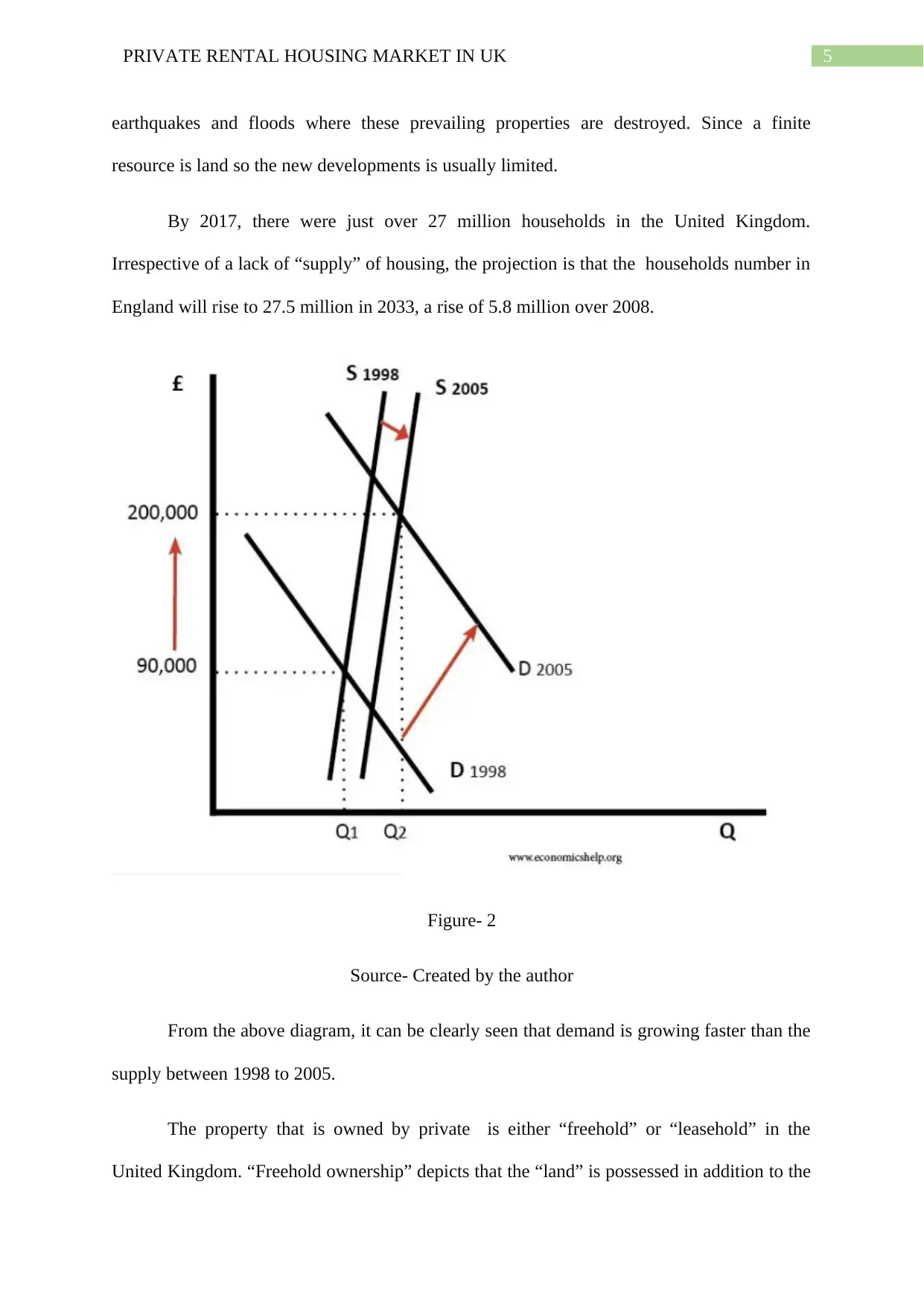
5PRIVATE RENTAL HOUSING MARKET IN UK
earthquakes and floods where these prevailing properties are destroyed. Since a finite
resource is land so the new developments is usually limited.
By 2017, there were just over 27 million households in the United Kingdom.
Irrespective of a lack of “supply” of housing, the projection is that the households number in
England will rise to 27.5 million in 2033, a rise of 5.8 million over 2008.
Figure- 2
Source- Created by the author
From the above diagram, it can be clearly seen that demand is growing faster than the
supply between 1998 to 2005.
The property that is owned by private is either “freehold” or “leasehold” in the
United Kingdom. “Freehold ownership” depicts that the “land” is possessed in addition to the
earthquakes and floods where these prevailing properties are destroyed. Since a finite
resource is land so the new developments is usually limited.
By 2017, there were just over 27 million households in the United Kingdom.
Irrespective of a lack of “supply” of housing, the projection is that the households number in
England will rise to 27.5 million in 2033, a rise of 5.8 million over 2008.
Figure- 2
Source- Created by the author
From the above diagram, it can be clearly seen that demand is growing faster than the
supply between 1998 to 2005.
The property that is owned by private is either “freehold” or “leasehold” in the
United Kingdom. “Freehold ownership” depicts that the “land” is possessed in addition to the
⊘ This is a preview!⊘
Do you want full access?
Subscribe today to unlock all pages.

Trusted by 1+ million students worldwide
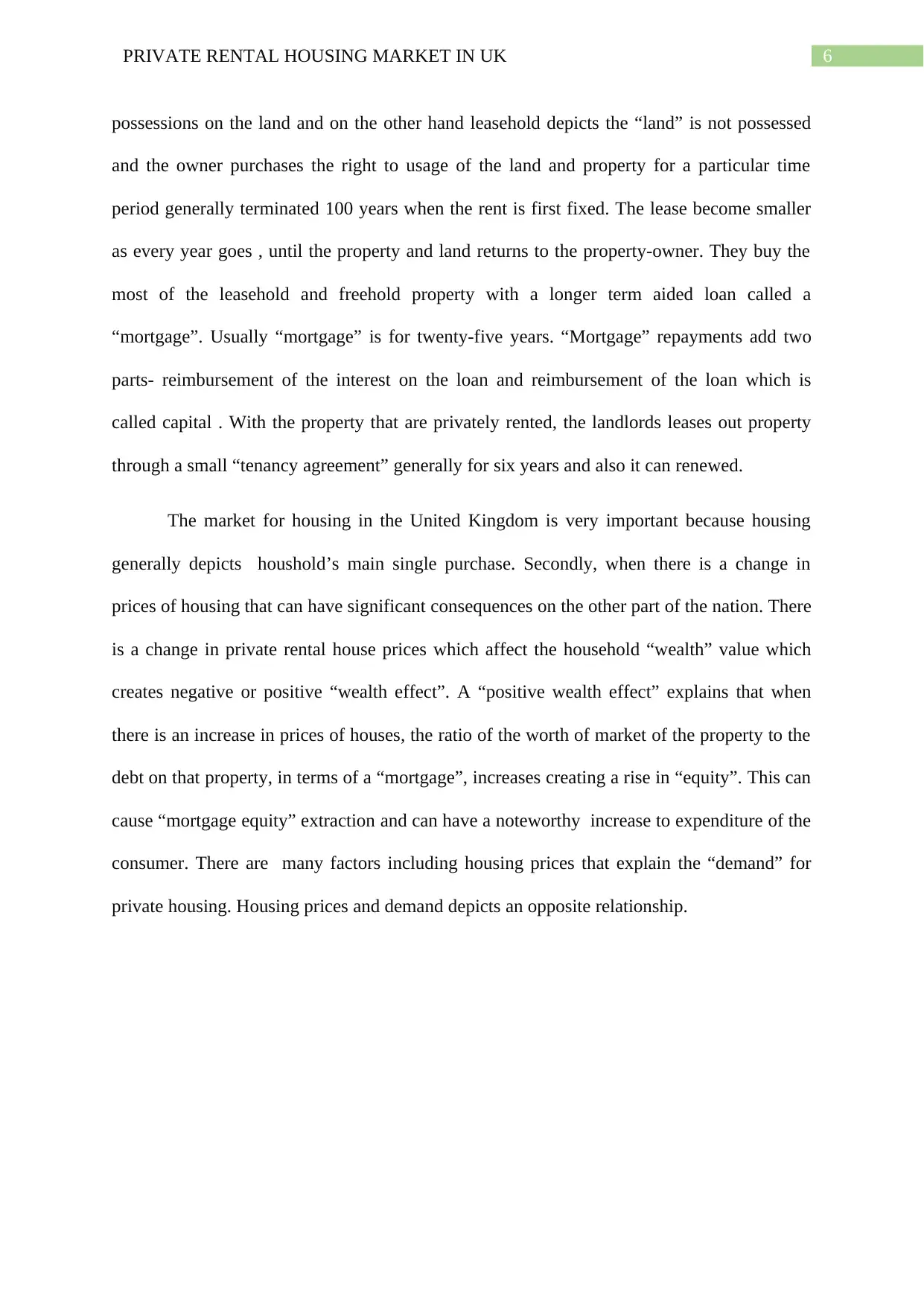
6PRIVATE RENTAL HOUSING MARKET IN UK
possessions on the land and on the other hand leasehold depicts the “land” is not possessed
and the owner purchases the right to usage of the land and property for a particular time
period generally terminated 100 years when the rent is first fixed. The lease become smaller
as every year goes , until the property and land returns to the property-owner. They buy the
most of the leasehold and freehold property with a longer term aided loan called a
“mortgage”. Usually “mortgage” is for twenty-five years. “Mortgage” repayments add two
parts- reimbursement of the interest on the loan and reimbursement of the loan which is
called capital . With the property that are privately rented, the landlords leases out property
through a small “tenancy agreement” generally for six years and also it can renewed.
The market for housing in the United Kingdom is very important because housing
generally depicts houshold’s main single purchase. Secondly, when there is a change in
prices of housing that can have significant consequences on the other part of the nation. There
is a change in private rental house prices which affect the household “wealth” value which
creates negative or positive “wealth effect”. A “positive wealth effect” explains that when
there is an increase in prices of houses, the ratio of the worth of market of the property to the
debt on that property, in terms of a “mortgage”, increases creating a rise in “equity”. This can
cause “mortgage equity” extraction and can have a noteworthy increase to expenditure of the
consumer. There are many factors including housing prices that explain the “demand” for
private housing. Housing prices and demand depicts an opposite relationship.
possessions on the land and on the other hand leasehold depicts the “land” is not possessed
and the owner purchases the right to usage of the land and property for a particular time
period generally terminated 100 years when the rent is first fixed. The lease become smaller
as every year goes , until the property and land returns to the property-owner. They buy the
most of the leasehold and freehold property with a longer term aided loan called a
“mortgage”. Usually “mortgage” is for twenty-five years. “Mortgage” repayments add two
parts- reimbursement of the interest on the loan and reimbursement of the loan which is
called capital . With the property that are privately rented, the landlords leases out property
through a small “tenancy agreement” generally for six years and also it can renewed.
The market for housing in the United Kingdom is very important because housing
generally depicts houshold’s main single purchase. Secondly, when there is a change in
prices of housing that can have significant consequences on the other part of the nation. There
is a change in private rental house prices which affect the household “wealth” value which
creates negative or positive “wealth effect”. A “positive wealth effect” explains that when
there is an increase in prices of houses, the ratio of the worth of market of the property to the
debt on that property, in terms of a “mortgage”, increases creating a rise in “equity”. This can
cause “mortgage equity” extraction and can have a noteworthy increase to expenditure of the
consumer. There are many factors including housing prices that explain the “demand” for
private housing. Housing prices and demand depicts an opposite relationship.
Paraphrase This Document
Need a fresh take? Get an instant paraphrase of this document with our AI Paraphraser
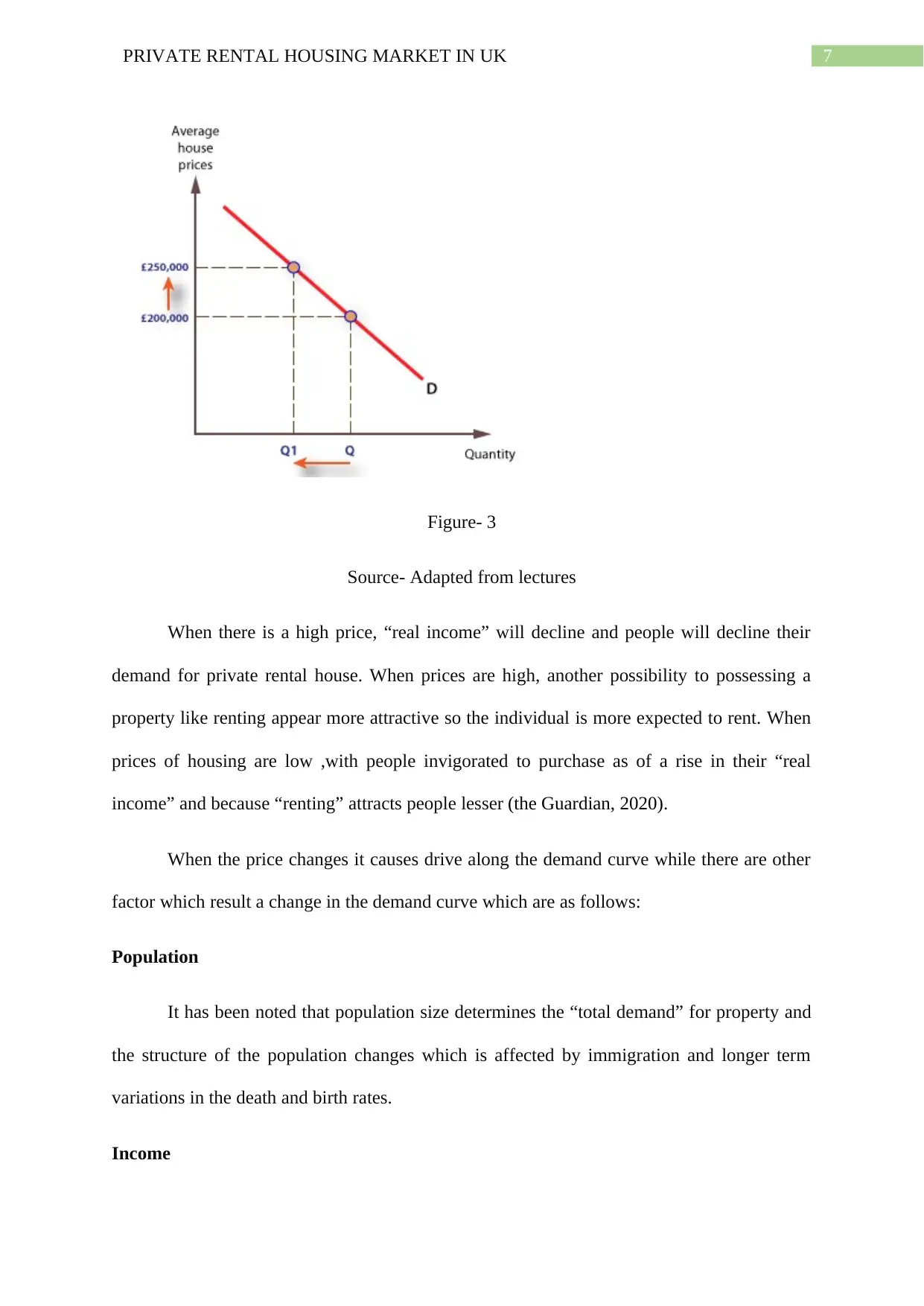
7PRIVATE RENTAL HOUSING MARKET IN UK
Figure- 3
Source- Adapted from lectures
When there is a high price, “real income” will decline and people will decline their
demand for private rental house. When prices are high, another possibility to possessing a
property like renting appear more attractive so the individual is more expected to rent. When
prices of housing are low ,with people invigorated to purchase as of a rise in their “real
income” and because “renting” attracts people lesser (the Guardian, 2020).
When the price changes it causes drive along the demand curve while there are other
factor which result a change in the demand curve which are as follows:
Population
It has been noted that population size determines the “total demand” for property and
the structure of the population changes which is affected by immigration and longer term
variations in the death and birth rates.
Income
Figure- 3
Source- Adapted from lectures
When there is a high price, “real income” will decline and people will decline their
demand for private rental house. When prices are high, another possibility to possessing a
property like renting appear more attractive so the individual is more expected to rent. When
prices of housing are low ,with people invigorated to purchase as of a rise in their “real
income” and because “renting” attracts people lesser (the Guardian, 2020).
When the price changes it causes drive along the demand curve while there are other
factor which result a change in the demand curve which are as follows:
Population
It has been noted that population size determines the “total demand” for property and
the structure of the population changes which is affected by immigration and longer term
variations in the death and birth rates.
Income
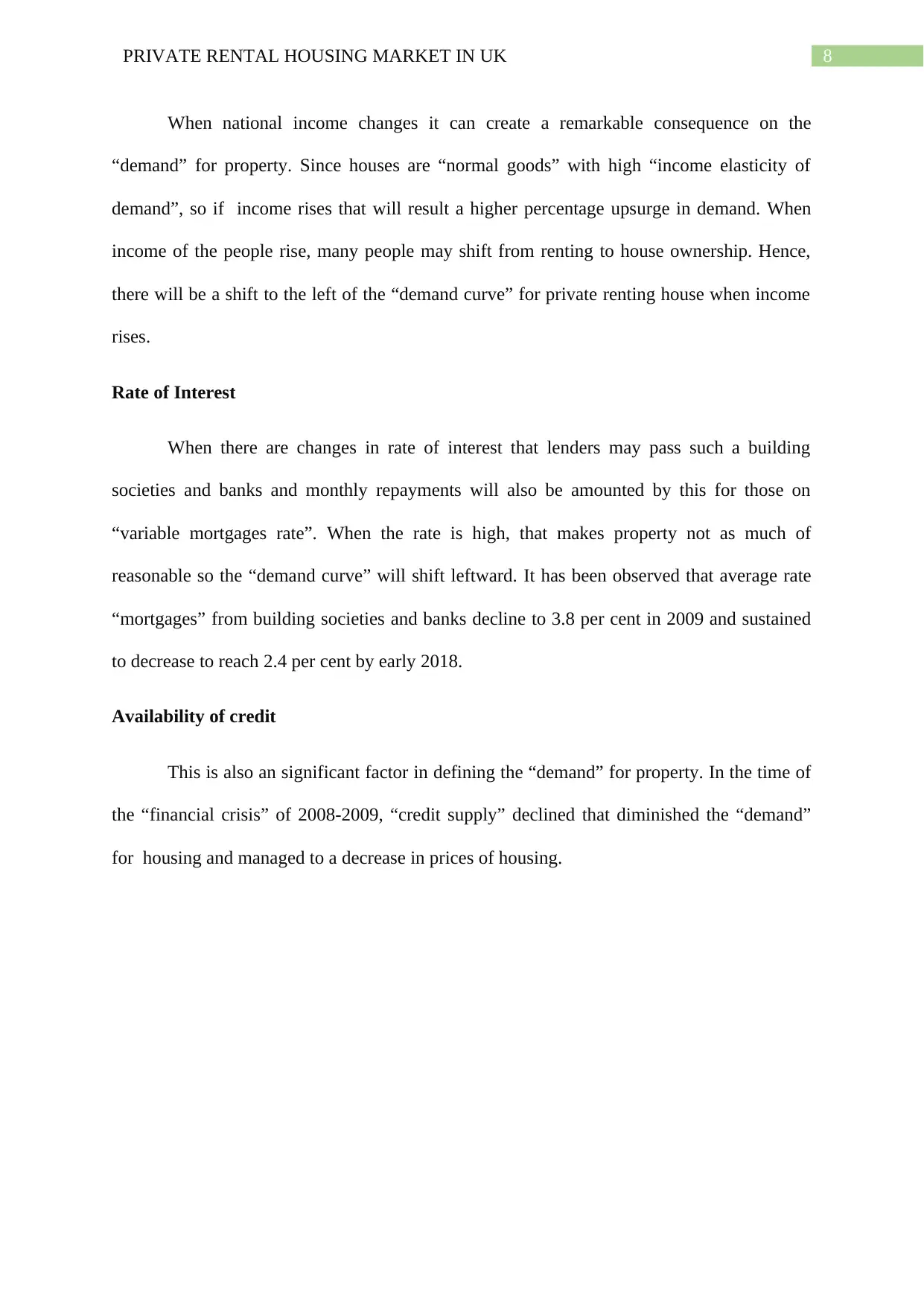
8PRIVATE RENTAL HOUSING MARKET IN UK
When national income changes it can create a remarkable consequence on the
“demand” for property. Since houses are “normal goods” with high “income elasticity of
demand”, so if income rises that will result a higher percentage upsurge in demand. When
income of the people rise, many people may shift from renting to house ownership. Hence,
there will be a shift to the left of the “demand curve” for private renting house when income
rises.
Rate of Interest
When there are changes in rate of interest that lenders may pass such a building
societies and banks and monthly repayments will also be amounted by this for those on
“variable mortgages rate”. When the rate is high, that makes property not as much of
reasonable so the “demand curve” will shift leftward. It has been observed that average rate
“mortgages” from building societies and banks decline to 3.8 per cent in 2009 and sustained
to decrease to reach 2.4 per cent by early 2018.
Availability of credit
This is also an significant factor in defining the “demand” for property. In the time of
the “financial crisis” of 2008-2009, “credit supply” declined that diminished the “demand”
for housing and managed to a decrease in prices of housing.
When national income changes it can create a remarkable consequence on the
“demand” for property. Since houses are “normal goods” with high “income elasticity of
demand”, so if income rises that will result a higher percentage upsurge in demand. When
income of the people rise, many people may shift from renting to house ownership. Hence,
there will be a shift to the left of the “demand curve” for private renting house when income
rises.
Rate of Interest
When there are changes in rate of interest that lenders may pass such a building
societies and banks and monthly repayments will also be amounted by this for those on
“variable mortgages rate”. When the rate is high, that makes property not as much of
reasonable so the “demand curve” will shift leftward. It has been observed that average rate
“mortgages” from building societies and banks decline to 3.8 per cent in 2009 and sustained
to decrease to reach 2.4 per cent by early 2018.
Availability of credit
This is also an significant factor in defining the “demand” for property. In the time of
the “financial crisis” of 2008-2009, “credit supply” declined that diminished the “demand”
for housing and managed to a decrease in prices of housing.
⊘ This is a preview!⊘
Do you want full access?
Subscribe today to unlock all pages.

Trusted by 1+ million students worldwide
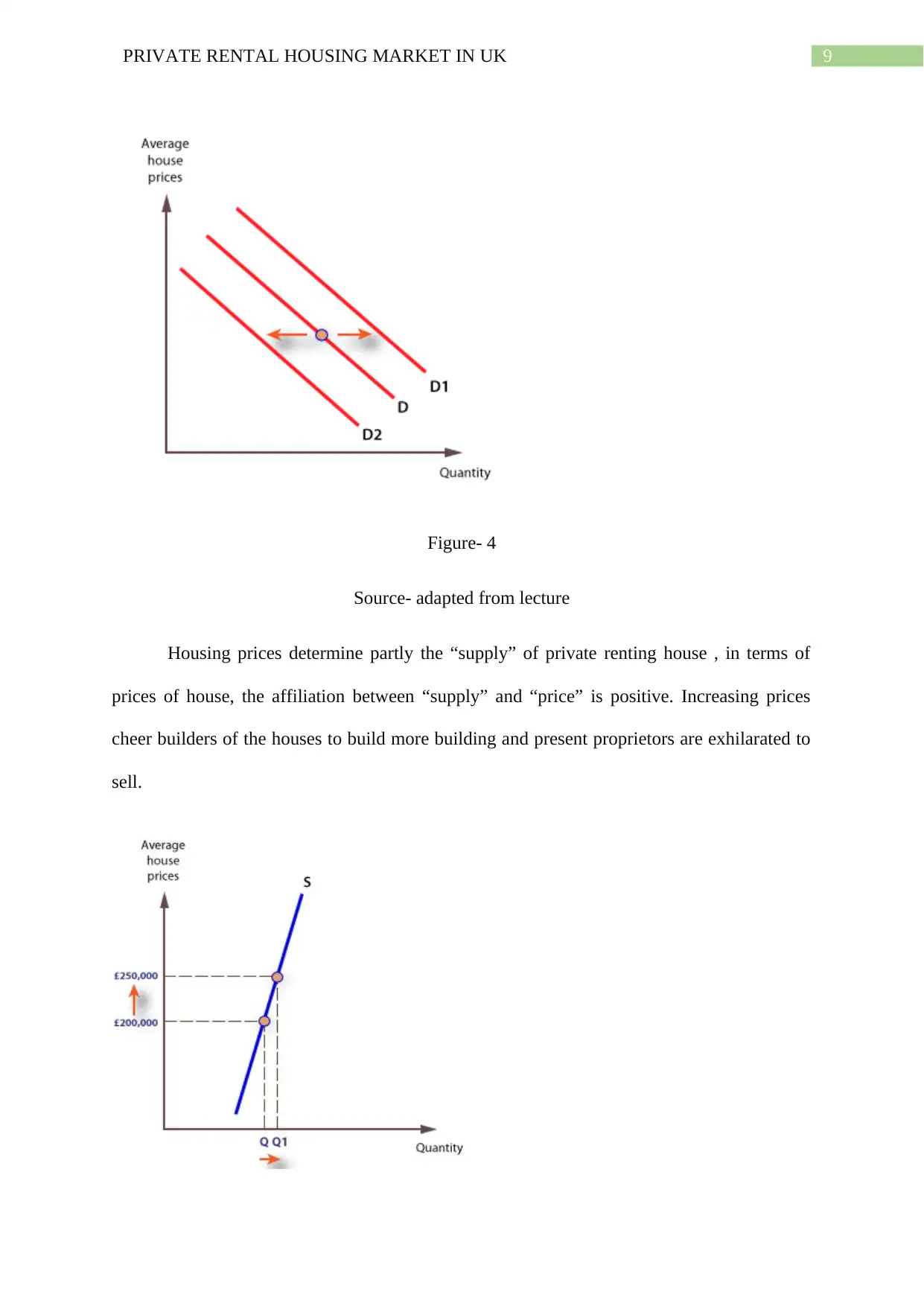
9PRIVATE RENTAL HOUSING MARKET IN UK
Figure- 4
Source- adapted from lecture
Housing prices determine partly the “supply” of private renting house , in terms of
prices of house, the affiliation between “supply” and “price” is positive. Increasing prices
cheer builders of the houses to build more building and present proprietors are exhilarated to
sell.
Figure- 4
Source- adapted from lecture
Housing prices determine partly the “supply” of private renting house , in terms of
prices of house, the affiliation between “supply” and “price” is positive. Increasing prices
cheer builders of the houses to build more building and present proprietors are exhilarated to
sell.
Paraphrase This Document
Need a fresh take? Get an instant paraphrase of this document with our AI Paraphraser
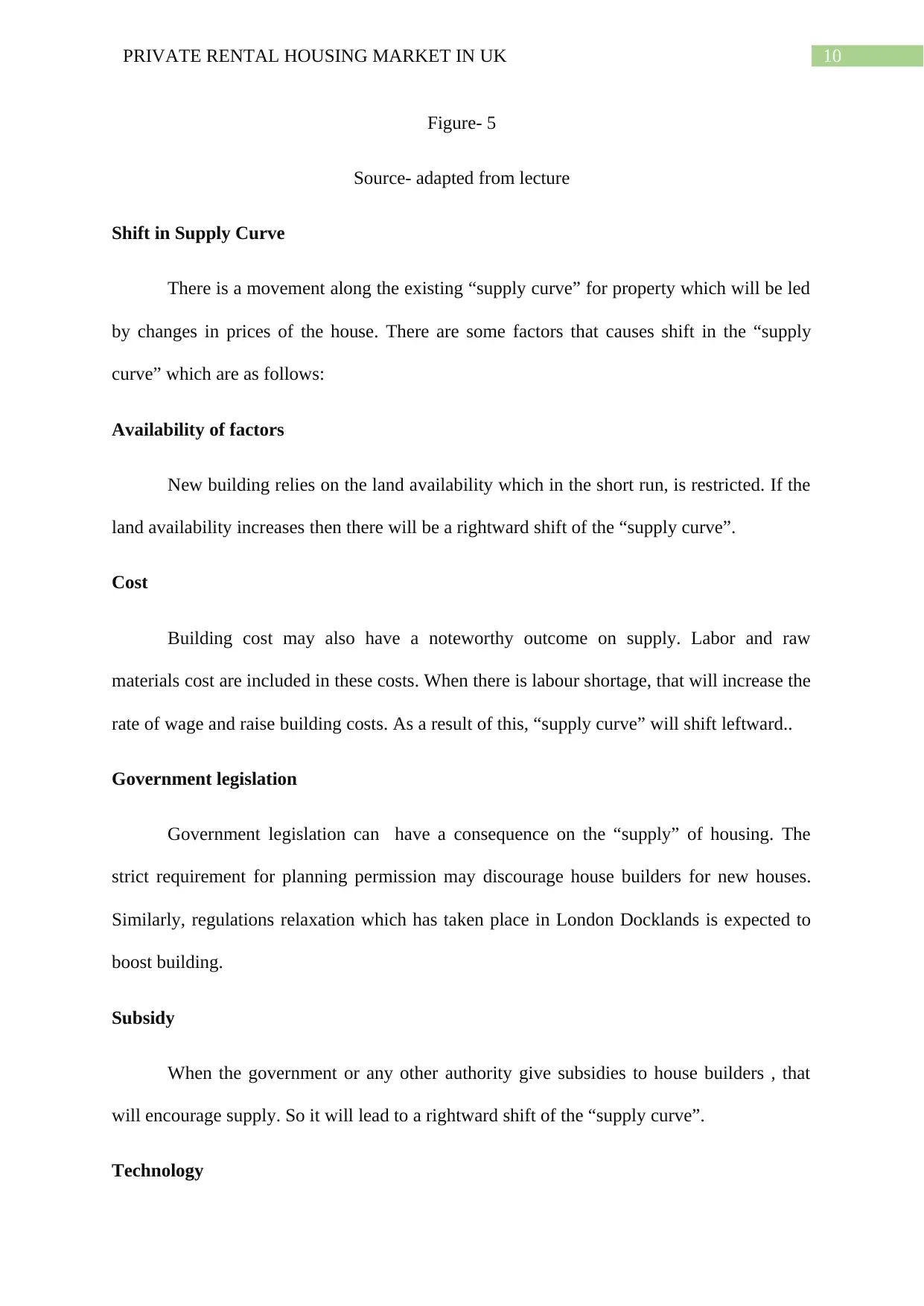
10PRIVATE RENTAL HOUSING MARKET IN UK
Figure- 5
Source- adapted from lecture
Shift in Supply Curve
There is a movement along the existing “supply curve” for property which will be led
by changes in prices of the house. There are some factors that causes shift in the “supply
curve” which are as follows:
Availability of factors
New building relies on the land availability which in the short run, is restricted. If the
land availability increases then there will be a rightward shift of the “supply curve”.
Cost
Building cost may also have a noteworthy outcome on supply. Labor and raw
materials cost are included in these costs. When there is labour shortage, that will increase the
rate of wage and raise building costs. As a result of this, “supply curve” will shift leftward..
Government legislation
Government legislation can have a consequence on the “supply” of housing. The
strict requirement for planning permission may discourage house builders for new houses.
Similarly, regulations relaxation which has taken place in London Docklands is expected to
boost building.
Subsidy
When the government or any other authority give subsidies to house builders , that
will encourage supply. So it will lead to a rightward shift of the “supply curve”.
Technology
Figure- 5
Source- adapted from lecture
Shift in Supply Curve
There is a movement along the existing “supply curve” for property which will be led
by changes in prices of the house. There are some factors that causes shift in the “supply
curve” which are as follows:
Availability of factors
New building relies on the land availability which in the short run, is restricted. If the
land availability increases then there will be a rightward shift of the “supply curve”.
Cost
Building cost may also have a noteworthy outcome on supply. Labor and raw
materials cost are included in these costs. When there is labour shortage, that will increase the
rate of wage and raise building costs. As a result of this, “supply curve” will shift leftward..
Government legislation
Government legislation can have a consequence on the “supply” of housing. The
strict requirement for planning permission may discourage house builders for new houses.
Similarly, regulations relaxation which has taken place in London Docklands is expected to
boost building.
Subsidy
When the government or any other authority give subsidies to house builders , that
will encourage supply. So it will lead to a rightward shift of the “supply curve”.
Technology
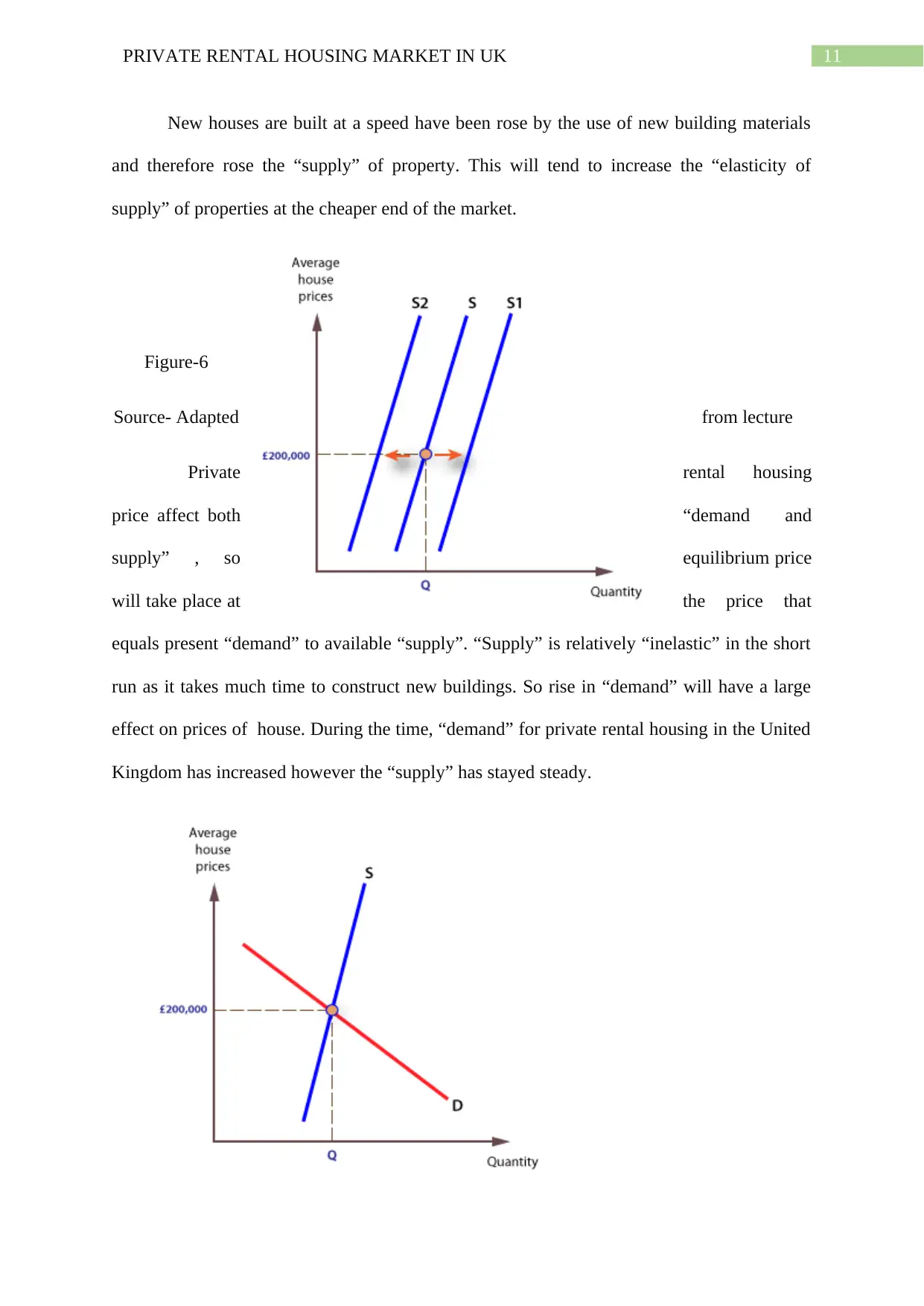
11PRIVATE RENTAL HOUSING MARKET IN UK
New houses are built at a speed have been rose by the use of new building materials
and therefore rose the “supply” of property. This will tend to increase the “elasticity of
supply” of properties at the cheaper end of the market.
Figure-6
Source- Adapted from lecture
Private rental housing
price affect both “demand and
supply” , so equilibrium price
will take place at the price that
equals present “demand” to available “supply”. “Supply” is relatively “inelastic” in the short
run as it takes much time to construct new buildings. So rise in “demand” will have a large
effect on prices of house. During the time, “demand” for private rental housing in the United
Kingdom has increased however the “supply” has stayed steady.
New houses are built at a speed have been rose by the use of new building materials
and therefore rose the “supply” of property. This will tend to increase the “elasticity of
supply” of properties at the cheaper end of the market.
Figure-6
Source- Adapted from lecture
Private rental housing
price affect both “demand and
supply” , so equilibrium price
will take place at the price that
equals present “demand” to available “supply”. “Supply” is relatively “inelastic” in the short
run as it takes much time to construct new buildings. So rise in “demand” will have a large
effect on prices of house. During the time, “demand” for private rental housing in the United
Kingdom has increased however the “supply” has stayed steady.
⊘ This is a preview!⊘
Do you want full access?
Subscribe today to unlock all pages.

Trusted by 1+ million students worldwide
1 out of 20
Related Documents
Your All-in-One AI-Powered Toolkit for Academic Success.
+13062052269
info@desklib.com
Available 24*7 on WhatsApp / Email
![[object Object]](/_next/static/media/star-bottom.7253800d.svg)
Unlock your academic potential
Copyright © 2020–2025 A2Z Services. All Rights Reserved. Developed and managed by ZUCOL.





